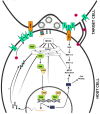Molecular Studies of HTLV-1 Replication: An Update
- PMID: 26828513
- PMCID: PMC4776186
- DOI: 10.3390/v8020031
Molecular Studies of HTLV-1 Replication: An Update
Abstract
Human T-cell leukemia virus type 1 (HTLV-1) was the first human retrovirus discovered. Studies on HTLV-1 have been instrumental for our understanding of the molecular pathology of virus-induced cancers. HTLV-1 is the etiological agent of an adult T-cell leukemia (ATL) and can lead to a variety of neurological pathologies, including HTLV-1-associated-myelopathy/tropical spastic paraparesis (HAM/TSP). The ability to treat the aggressive ATL subtypes remains inadequate. HTLV-1 replicates by (1) an infectious cycle involving virus budding and infection of new permissive target cells and (2) mitotic division of cells harboring an integrated provirus. Virus replication initiates host antiviral immunity and the checkpoint control of cell proliferation, but HTLV-1 has evolved elegant strategies to counteract these host defense mechanisms to allow for virus persistence. The study of the molecular biology of HTLV-1 replication has provided crucial information for understanding HTLV-1 replication as well as aspects of viral replication that are shared between HTLV-1 and human immunodeficiency virus type 1 (HIV-1). Here in this review, we discuss the various stages of the virus replication cycle-both foundational knowledge as well as current updates of ongoing research that is important for understanding HTLV-1 molecular pathogenesis as well as in developing novel therapeutic strategies.
Keywords: antiretroviral; deltaretrovirus; lentivirus.
Figures


Similar articles
-
Modes of Human T Cell Leukemia Virus Type 1 Transmission, Replication and Persistence.Viruses. 2015 Jul 7;7(7):3603-24. doi: 10.3390/v7072793. Viruses. 2015. PMID: 26198240 Free PMC article. Review.
-
Tropical spastic paraparesis and HTLV-1 associated myelopathy: clinical, epidemiological, virological and therapeutic aspects.Rev Neurol (Paris). 2012 Mar;168(3):257-69. doi: 10.1016/j.neurol.2011.12.006. Epub 2012 Mar 7. Rev Neurol (Paris). 2012. PMID: 22405461 Review.
-
Long Terminal Repeat Circular DNA as Markers of Active Viral Replication of Human T Lymphotropic Virus-1 in Vivo.Viruses. 2016 Mar 14;8(3):80. doi: 10.3390/v8030080. Viruses. 2016. PMID: 26985903 Free PMC article.
-
[Virological aspects of HTLV-1 infection and new therapeutical concepts].Bull Soc Pathol Exot. 2011 Aug;104(3):181-7. doi: 10.1007/s13149-011-0161-5. Epub 2011 May 23. Bull Soc Pathol Exot. 2011. PMID: 21607661 Review. French.
-
Double control systems for human T-cell leukemia virus type 1 by innate and acquired immunity.Cancer Sci. 2011 Apr;102(4):670-6. doi: 10.1111/j.1349-7006.2011.01862.x. Epub 2011 Feb 28. Cancer Sci. 2011. PMID: 21219540 Review.
Cited by
-
Development of a Novel HTLV-1 Protease: Human Fcγ1 Recombinant Fusion Molecule in the CHO Eukaryotic Expression System.Appl Biochem Biotechnol. 2023 Mar;195(3):1862-1876. doi: 10.1007/s12010-022-04259-y. Epub 2022 Nov 18. Appl Biochem Biotechnol. 2023. PMID: 36399306 Free PMC article.
-
Development of a Monoclonal Antibody Targeting HTLV-1 Envelope gp46 Glycoprotein and Its Application to Near-Infrared Photoimmuno-Antimicrobial Strategy.Viruses. 2022 Sep 29;14(10):2153. doi: 10.3390/v14102153. Viruses. 2022. PMID: 36298708 Free PMC article.
-
In vitro Susceptibility of Human Cell Lines Infection by Bovine Leukemia Virus.Front Microbiol. 2022 Mar 14;13:793348. doi: 10.3389/fmicb.2022.793348. eCollection 2022. Front Microbiol. 2022. PMID: 35359744 Free PMC article.
-
Critical Role of the Human T-Cell Leukemia Virus Type 1 Capsid N-Terminal Domain for Gag-Gag Interactions and Virus Particle Assembly.J Virol. 2018 Jun 29;92(14):e00333-18. doi: 10.1128/JVI.00333-18. Print 2018 Jul 15. J Virol. 2018. PMID: 29695435 Free PMC article.
-
Onco-Pathogen Mediated Cancer Progression and Associated Signaling Pathways in Cancer Development.Pathogens. 2023 May 28;12(6):770. doi: 10.3390/pathogens12060770. Pathogens. 2023. PMID: 37375460 Free PMC article. Review.
References
-
- Poiesz B.J., Ruscetti F.W., Gazdar A.F., Bunn P.A., Minna J.D., Gallo R.C. Detection and isolation of type C retrovirus particles from fresh and cultured lymphocytes of a patient with cutaneous T-cell lymphoma. Proc. Natl. Acad. Sci. USA. 1980;77:7415–7419. doi: 10.1073/pnas.77.12.7415. - DOI - PMC - PubMed
Publication types
MeSH terms
Grants and funding
LinkOut - more resources
Full Text Sources
Other Literature Sources
Miscellaneous

